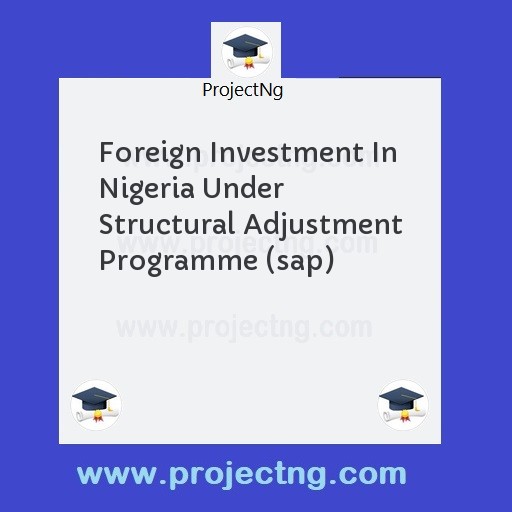Foreign Investment In Nigeria Under Structural Adjustment Programme (sap)
Accounting Project Topics
Get the Complete Project Materials Now! »
FOREIGN INVESTMENT IN NIGERIA UNDER STRUCTURAL ADJUSTMENT PROGRAMME (SAP)
TABLE OF CONTENTS
Title Page
Approval Page
Dedication
Acknowledgement
Abstract
Table of contents
CHAPTER ONE
1.1 Introduction
1.2 Objectives of the study
1.3 Significance of Problem
1.4 Statement of Problem
1.5 Hypothesis Formulation
1.6 Scope and Limitation of the Study
1.7 Definition of terms
CHAPTER TWO
2.0 REVIEW OF RELATED LITERATION
2.1 The government efforts towards attracting foreign investments
2.2 The role of Industrial development co-ordination committee in the execution of foreign policy under (SAP)
2.3 The concept o investment
2.4 The concept of foreign investment
2.5 Portfolio investment
2.6 Foreign investment and multinational corporation (MNC)
2.7 Foreign investment and the 1991budget.
CHAPTER THREE
RESEARCH DESIGN AND METHODOLOGY
3.1 Study Area
3.2 Sources of data
3.3 Data collection technique
3.4 Sample for the study
3.5 Judgment sampling
3.6 Statistical method of Analysis
CHAPTER FOUR
PRESENTATION AND ANALYSIS OF DATA
4.1 Presentation of data
4.2 Analysis of data
4.3 The devaluation of Naira and foreign investment
4.4 The role second-tire foreign exchange market
4.5 Problem confronting Nigerian’s balance of payment.
4.6 Foreign trade under SAP
4.7 Hypothesis testing
CHAPTER FIVE
SUMMARY OF FINDINGS CONCLUSION AND RECOMMENDATION
Findings
Conclusions
Recommendations
Bibliography
Appendix
Questionnaire
CHAPTER ONE
1.1 INTRDUCTION
According to annual report of the Central Bank of Nigeria, the Nigeria economy has performed less well in the 1980’s than the 1970’s. Much of the growth in both periods was based on performance of the oil sector. By 1970 oil output stood at 558 million barrels and increased to 823 million barrels by 1973. Between 1975 – 1985, oil output per day averaged between 1.8 and 2.3 million barrels respectively. With the dramatic rise in oil price in 1973 and 1974 oil came to account for 31.9% of growth in real gross domestic products and has since continued to dominate economic performance in Niger sector. Although the aim of the policy was to translate oil revenue into directly productive structures and promote long-term development prospects, the imperatives and political pressure to spend led to consolable waste and to oil boom in construction activities.
The oil include rise in the exchange rate also gave negative protection to agriculture and eroded it’s significance in the economy from about 40% of the gross domestic product I the early 1970’s to 1980’s. According, food imports which were only 200,000 lorus the 1960’s has increase tremendously to 399,000 tones in 1974, reaching a pear level of 2,441,000 lorus in 1981.
By 1985 capacity utilization of most industries was below 20% owing to lack of foreign exchanges raw materials and sparse parts. Inflation had also attained an intolerable level. When therefore, the past administration in Nigeria came to power (the Babangida Administration) in August 1985, it looks a critical look at the magnititude of the economic problems facing the nation and in July 1986, it adopted a programme known as Structural Adjustment Programme (SAP) as a means of tackling these preambles.
The entailed, among other things the diversification of the economics so as to make it more resilient to external forces. The import licensing system was abolished and the inter-bank foreign exchange system was introduced in September 1986 with a view to making the naira achieve a realistic exchange rate. The commodities abroad were abolished and which various government subsidies were either removed or splashed by means of commercialization and privatization; such as telecommunications and electricity.
Generally, market forces in the allocation of resources replaced administrative controls. Public investments were generally reduced in
Be the First to Share On Social

Enjoying our content?
Don't miss out on new videos! Subscribe to our YouTube channel for more awesome content.
Subscribe Now!













